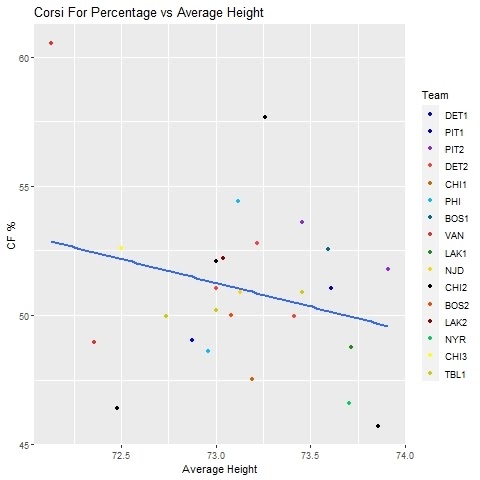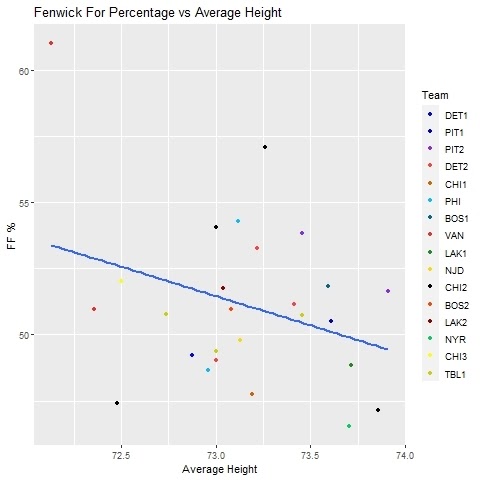By: Brendan Zytowski

Introduction
Hockey is often described as the most violent of the most followed global team sports. This is in part due to the constant rough-housing and physical nature of professional hockey. A common myth parroted by hockey analysts, scouts, coaches, and even General Managers, is that size trumps all. The saying, "you can't teach size" is a double edged sword; it holds truth on the surface level as big, strong players are tough to duel, but physical abilities are only a part of what makes a great player great. Great players are evaluated by their success in the playoffs and how important they were to their teams’ success.
Playoff hockey is unlike regular season hockey in that the frequency of hits, shots, and injuries increases dramatically as teams experience 'do or die' desperation. 'Old-time hockey' is a common phrase issued by commentators whenever play becomes more intense and physical as emotions run high. In theory, since size cannot be taught, larger teams should outperform smaller teams because they will be more physically punishing and be able to 'out-work' their opponents as a result (hockey slang deserves it's own dictionary). For example, the 2013-14 Los Angeles Kings had an average height of nearly 74 inches, and an average weight of 210 pounds which is an inch taller and ten pounds heavier than their opponents, the New York Rangers, on average. That series only lasted five games with the Rangers failing to score more than two goals in four of those five games.
Why is there such an emphasis on size in hockey? The idea is that there will be fewer scoring chances for the smaller team and more scoring chances for the bigger team because the smaller team will be boxed out of high scoring areas and will not have any open passing lanes to teammates. On paper this seems like a foolproof defense, simply stop the opposing team from getting near your net. However, recent trends indicate that being bigger than your opponent does not correlate to a higher chance of success. Using data from naturalstattrick.com, I aim to show a team’s average height and weight is not the most important factor in determining playoff success.
Debunking the Myth

Here is a bar graph comparing the average heights of the Stanley Cup champions and runners-up since the 2007-08 season. The winning teams are the teams in the odd intervals, and the runners-up are the teams in the even intervals. Eight of the thirteen listed matchups were won by the team that had a lower average height, with the largest difference being the 2007-08 Detroit Red Wings defeating the Pittsburgh Penguins who have the second highest average height of any team in this graph.
Interestingly, The next year shows the same team matchup, but the Penguins beat the Red Wings after a personnel change for both teams that left the Red Wings nearly an inch taller on average than the Penguins. In every series Pittsburgh wins, against the Red Wings, San Jose Sharks and Nashville Predators, they are the smaller team in the series. Their best players in each of those series, Sidney Crosby, Evgeni Malkin, and Kris Letang, are all listed at 6’3” (Malkin) or shorter, and they are all elite players, with Malkin winning the three league awards in 2012 including the MVP award, and Sidney Crosby being arguably the greatest player since Wayne Gretzky.
There are a number of statistics used to analyze the performance of a team in a game such as expected goals, scoring chances, shots, shooting percentage to name a few. Two newer and perhaps more enlightening statistics are Corsi and Fenwick. Corsi measures the difference between Corsi For (CF), the number of shot attempts for at even strength, and Corsi Against (CA), the number of unblocked shot attempts against at even strength. Fenwick, split into Fenwick For (FF) and Fenwick Against (FA), is the same as Corsi but instead measures unblocked shot attempts. Essentially, Corsi and Fenwick measure how good a player is at limiting shots against and maximizing shots for. So the higher the Corsi and Fenwick, the better the player in theory.
We have here scatterplots of CF% and FF% plotted against the average height of each team from the previous bar graph with an overlaid best-fit line to show the trend. The trendline is a bit misleading, as it is heavily influenced by the 2007-08 Detroit Red Wings. Looking at the rest of the points suggests there really is no linear relationship between CF% and FF% with average height as all of the points are scattered without a discernable pattern. So it is possible that a team’s size has little to no impact on their success in the playoffs depending on how skilled the team is.
Conclusion

In the picture above stand Conor Sheary, listed at 5’9”, 178 lbs, and Zdeno Chara, listed at 6’9”, 250 lbs. Chara captained the Boston Bruins to the Stanley Cup in the 2010-11 season and will likely be a first ballot Hall of Fame inductee after he retires, while Conor Sheary is putting together a solid NHL career having already won two Stanley Cups with Pittsburgh. Both are players that any team would like to have on their roster for different reasons, Chara for his physical prowess and defensive acumen (he won the Norris Trophy for best defenseman in the 2008-09 season), and Sheary for his two-way style of play that makes him a versatile roster player. Chara is 43 years old and has played 23 seasons in the league which is an incredible feat.

A young Chara was the embodiment of ‘Old-time hockey’, regularly racking upwards of 120 penalty minutes and over 200 hits per season while putting up solid goal scoring totals for a defenseman. But in that time Chara never won a Stanley Cup. Sure, Chara has size that cannot be taught, but even with his size he has had to learn to play smarter by taking fewer penalties and choosing his battles more carefully in the same way a player of Sheary’s stature has to play to stay in the league.
Looking at their respective career penalty trends, Sheary has never exceeded 25 penalty minutes per season while Chara has never dipped below 45 penalty minutes save for 2020-21. However, Chara’s penalty minutes follow a decreasing trend after the 2000-2001 season that sharply drops around the 2005-2006 season when he joins the Boston Bruins from the Ottawa Senators at 29 years old. Of note, Chara appeared in the Stanley Cup finals in 2011, 2013, and 2019, winning in 2011 against the Vancouver Canucks. Chara put up fewer than 90 penalty minutes in the 2010-11 season, and fewer than 75 penalty minutes in the 2012-13 and 2018-19 seasons. Penalty minutes are detrimental to a team’s success, especially in the playoffs when every goal can decide a series. Chara has had more success when playing smarter, not bigger.
It is difficult to determine the importance of size for NHL teams. However, it is likely that there are more important factors teams should target when building their teams, and the adage ‘you can’t teach size’ should not be taken so literally.
Sources: naturalstattrick.com, quanthockey.com




Comments